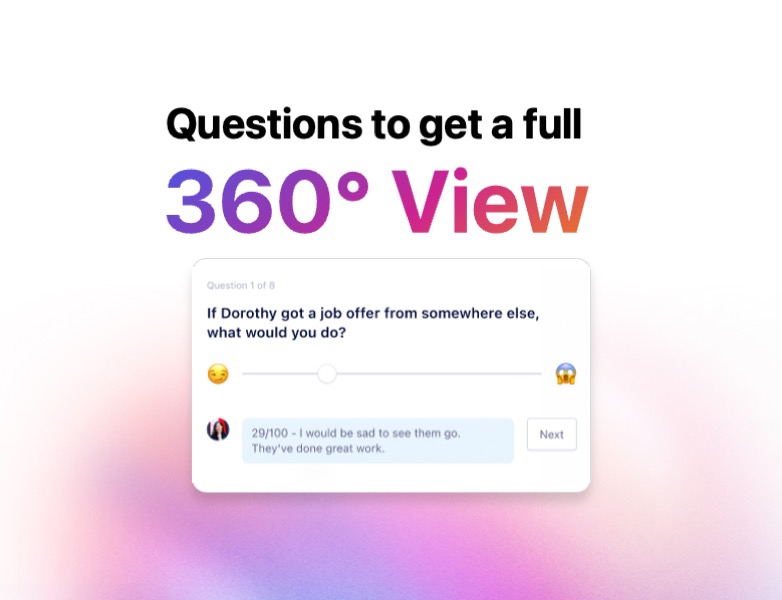14 Questions for Your Next Performance Review
7 min readPerformance Review Questions can help you make a 9-box grid, run calibration meetings, support succession planning, resource allocation... and most importantly facilitate great conversations.

In a performance review, the questions you ask are the catalyst for meaningful discussion between managers and employees. They help your team figure out what’s working, where there’s room for improvement and where you are headed. They can also surface any miscommunications and missed expectations that might go unchecked.
But those are not the only conversations. These questions build a rich data set to inform your talent strategy. Through thoughtful design you can populate a reporting system like a 9-box grid to help run calibration meetings, support succession planning and resource allocation.
To get the most out of a performance review, you want to get a 360-degree view. This means including assessment from multiple perspectives, such as managers, peers, and the employees themselves.
In this article we’ll cover:
- Questions to ask Managers about their team
- Questions to ask Employees about themselves
- Questions to ask Employees about their Peers
- Questions to ask Employees about their Managers
- A free template to get you started
Manager Evaluation of Employees
Managers’ evaluations of employee performance give a top-down perspective on individual employee performance. Beyond that they can help you identify future leaders, attrition risks, and gaps between role design and role execution.
Key areas that questions should address include:
- How would you rate [employee name]’s potential for future growth with the company? Understanding an employee’s potential helps map out prospective growth and succession plans.
- If [employee name] got a job offer somewhere else, what would you do? This question helps gauge the potential impact an employee’s departure might have on the team or organization.
- What’s your perception of [employee name]’s performance? Evaluating an employee’s performance and overall impact on the business.
- How would you rate [employee name]’s ability to meet job requirements? Reviewing an employee’s proficiency in completing job requirements offers insights into their skill proficiency and job fit.
- How would you rate [employee name]’s display of company values? A cultural fit ensures the employee is aligned with the company’s values and mission, fostering workplace harmony.
- How engaged do you feel [employee name] is at work? A measure of an employee’s engagement can depict how a manager perceives their commitment and job satisfaction.
The first two questions are more input to your talent strategy than fuel for the employee conversation. Over time responses build a picture of how employees are evolving in your organization and helps your team stay agile in how they deploy talent.
For the balance of the questions you are getting a rating to help support a development conversation and provide a way to compare across teams. The most interesting insight comes from looking at the difference between a manager’s response and the employee or peers response. These differences help you identify where there might be bias or miscommunication about expectations.
Other insights can come from a big delta between a performance score and the ability to meet job requirements. This reveals when a great employee is in the wrong seat or a role no longer serves the needs for the business. You want to create the opportunity to separate a person’s current match to a documented role, from their impact on the business and their future potential.
Employee Self-Evaluations
Self-assessments provide employees an opportunity to reflect on their performance, marking their agreements or disagreements with the manager’s evaluation.
Key areas that questions should address include:
- What’s your perception of your overall performance? How an employee rates their performance can highlight their self-perception and confidence in their role.
- How would you rate your ability to meet job requirements? Understanding an employee’s self-assessment of whether they meet their job requirements can offer insights into their perceived role understanding and competence.
- How would you rate your display of company values? The degree to which they believe they embody company values can speak volumes about their cultural alignment.
- How engaged do you feel at work? It’s essential to understand how employees view their engagement at work.
Again allowing the distinction between overall performance and match to job requirements allows an employee to provide context for why the business required them to do something different than their prescribed role. When this happens it presents the opportunity to recognize strong performance while still identifying areas for improvement.
The only engagement question that really matters is self-reported. Any low engagement reported should be addressed. If there is a big difference from what the manager reported then you may need to involve others. This represents both risk and opportunity. We know that engaged employees are more productive so when given the opportunity to address low engagement we need to act.
This is also information for your recruiting strategy. If someone remains unengaged or you are unable to meet their desired role progression, you will want to make sure you have plans in place.
Peer Evaluations
Peer evaluations contribute to a comprehensive picture of an employee’s interpersonal effectiveness. You do not want to overwhelm peer evaluators or ask them questions they do not have enough information to answer, for example specific questions related to goals or job requirements.
Key Question categories include:
- What’s your perception of [employee name]’s performance? Peer assessments of individual performance can provide a well-rounded view of an employee’s performance.
- How would you rate [employee name]’s display of company values? Understanding peers’ perceptions of an employee’s alignment with company values adds depth to the overall assessment.
These questions are so valuable for giving a manager a more complete picture of the impact their employee is having on the business and the team. Manager’s are not able to observe their employees in all situations. Asking peers to provide some perspective can challenge managers to consider their own perception or strengthen a view they have with additional detail.
You will want to encourage peers to submit honest feedback. This could mean keeping it anonymous. Ultimately you want peer feedback to be continuous and direct.
Employee Evaluation of Managers
Employee reviews of managers provide invaluable insights into leadership effectiveness. By giving employees the chance to submit feedback on their managers you provide rich context for their managers and open the door to identifying risk in your leadership structure.
Key areas to consider include:
- How well are you supported by your manager in your current role? How an employee perceives a manager’s supportiveness in their current role can shed light on the manager’s leadership and people management skills.
- How would you rate your manager’s involvement in helping shape your career? Employees rating the frequency and effectiveness of career-centered conversations portrays a manager’s investment in employee growth.
With their relationship with their manager accounting for 70% of the difference in employee engagement scores, understanding their effectiveness is hugely important. Skip level meetings throughout the year will help but not asking during a review cycle is a missed opportunity.
Analyze Talent across your Company
Asking the right questions can go a long way to creating a more agile and effective organization. You will want to iterate and evolve your approach. The changing needs and goals of an organization should be mirrored in the focus of your performance review process.
A well-thought-out performance review, facilitated by well-structured questions, can significantly contribute to strategic HR decisions and an overall boost in employee performance. Keep on improving the process, and everyone wins.
Download the template
Our thoughtfully designed questions covers key areas, from assessing future growth potential to measuring alignment with company values. But you might be looking to make some tweaks. We’ve got you covered with a free template that includes everything in this article (and a bit more).
Download it free, now.


